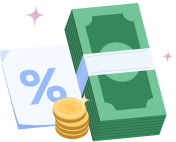Table of Contents
Lenders usually ask applicants for personal loans to present one or more forms of security to back up the secured personal loan they are applying for. This may be an asset that the borrower provides to the lender in order for the loan to be granted, which the lender can sell in case the borrower fails to pay back the loan as agreed.
What can be used as collateral for personal loan? This article defines the term collateral, the common types of assets people use, and the advantages or disadvantages of using them to secure a personal loan. Let’s dive in to stay informed!
What is Collateral?
Collateral often comes into focus when one takes out a loan. Think of any loan–home loan, auto loan, business loan–and collateral is central to the conversation. But what is it? And how important is it for you to secure a loan? Can I take out a loan without it? We answer all the questions in subsequent sections.
Read Related Article: How Can I Get Emergency Cash Fast Without Loans?
Definition and Purpose of Collateral
Collateral is an item of personal property that the borrower provides to the lender to provide security for the payment of a loan. If the borrower is unable to repay the loan, then the lender has the power to sell the collateral to recover the amount of the loan given. The purpose of collateral is to minimize the lenders’ risks and can result in improved loan conditions for the borrower.
How It Affects Loan Terms and Interest Rates
As the lender’s risk is reduced, providing an asset usually leads to lower interest rates and higher loan volume. This is handy for those with bad credit scores, but it is also valuable security to offer to lenders.
Secured vs. Unsecured Loans
The main difference between secured vs. unsecured loans is whether the lender requires collateral. Let us see the key differences of the same:
Key Differences and Implications
A secured loan is backed by a security, while an unsecured loan does not need security. Interest rates are usually lower than those of unsecured loans. However, the risks would be higher for the borrower in case of default because the lender would take the collateral pledged. On the other hand, unsecured loans attract higher interest rates because the lender is exposed to more risks.
Common Types of Collateral
Let’s see some common types of collateral loans:
Vehicles
Vehicles like cars, motorcycles, and automobiles are a very popular type of collateral for taking secured loans:
Cars, Motorcycles, and Other Automobiles
Most borrowers use their vehicle as security when getting a personal loan. This also encompasses cars, motorcycles, trucks, and any other kind of automobile, provided the automobiles are reasonably priced.
Valuation and Equity Requirements
Borrowers’ cars are usually evaluated at market value, and the borrower has to own the car or have a sizable amount of equity in it. If the car is still under financing, deducting the remaining loan balance from the car’s value will provide the remaining equity acceptable for collateral.
Real Estate
Giving real estate properties as collateral is one of the many options people go for. Let us see what all comes under this category:
Houses, Rental Properties, and Land
Real estate is another popular security type that borrowers use when securing a personal loan from an organization. Real property includes, but is not limited to, the borrower’s home, investment properties, or raw land.
Appraisal and Loan-to-Value Ratio
Credit creators typically assess the property to ascertain its market value at that given time. They also consider the loan-to-value ratio, whereby a borrower presents a statement of the loan amount against the property’s value. Generally, the lower the LTV ratio, the better the loan terms will be granted.
Savings and Investments
You can also use your savings and investments as collateral:
Cash and Cash Equivalents, CDs & Investment Account
Savings accounts, CDs, and investment portfolios such as stocks and bonds are also acceptable forms of collateral.
Read Related Article: Top 10 Personal Loan Terms You Must Know Before You Apply: Fine Print Decoded
Liquidity and Accessibility
Such assets are easy to sell, and thus, lenders consider them good security. Interest or returns from the investment can still be earned when borrowers utilize them as security, though limitations exist.
Other Potential Collateral
Apart from the above-listed collaterals, we have discussed other potential items that are accepted as collateral by the lenders:
High-Value Possessions
There are various high-value possessions that one can use as collateral:
Jewelry, Antiques, Collectibles
Collateral may consist of highly valuable items such as jewelry, antiques, or other rare collections, including documents and papers.
Appraisal and Valuation Process
Such goods usually require the assessment of valuators, who assess the worth of every item to be insured. Borrowers may need to prove the asset’s value and condition to the lender as collateral.
Business Assets
Various types of assets can be used as collateral to get a loan:
Equipment, Inventory, and Receivables
Personal loans can be secured for business owners using assets, such as equipment, inventory, and accounts receivable. This is usually the case with business loans. However, some personal loans also allow the use of business assets.
Read Related Article: Can You Balance Transfer a Personal Loan?
Eligibility Criteria and Restrictions
Lenders will consider the condition of business assets and the ease of selling them in case the need arises. This depends on the type of asset held and its marketability.
Risks and Considerations
Let us see the risks and considerations that one should keep in mind before giving collateral for a loan:
Loss of Collateral
If you fail to pay the loan in time, you can lose your collateral, and it can lead to various consequences:
Consequences of Defaulting on the Loan
In the case of secured credit, the lender can take possession of the asset pledged as security when the borrower fails to pay back the loan. For example, failure to pay a loan received and backed by a home may lead to the loss of the home.

Protecting Your Assets
It is also crucial to assess your capacity to repay the placed loans before using a precious asset to secure the funding. However, you should be very clear about the risks and have a plan for how to pay back before you lose the asset.
Interest Rates and Fees
The two main features that distinguish secured and unsecured loan offers are the interest rates and the fees. Let’s see how it is calculated:
Read Related Article: Can You Transfer a Mortgage Loan to Another Person?
Comparing Secured and Unsecured Loan Options
Secured loans are usually cheaper than unsecured loans, but the fees differ from one institution to another. There are tied and collateralized forms of credit to promote credit usage, and it is essential to consider the rates charged on both to decide which one to take.
Potential Cost Savings with Collateral
Leveraging assets can help debtors obtain a better interest rate and other loan terms, so it can help them save money. However, any such savings must be balanced against the loss of your asset in case of a foreclosure.
Pros and Cons
Some pros and cons come with using collateral for taking a secured loan:
Evaluating the Benefits and Drawbacks of Using Collateral
Collateral loans have the following benefits: First, they have relatively low interest rates; second, they have high loan limits; and third, they are approved for applicants with low credit scores. However, they are also one of the most dangerous forms of credit, as your property can be seized if you cannot pay the loan.
Considering Alternative Financing Options
Other sources of financing that a borrower may consider are unsecured personal loans and credit cards, which do not require collateral but have high costs and rigorous approval standards.
Seeking Professional Advice
It is very important to seek professional advice before keeping any of your big assets for collateral:
Consulting with a Financial Advisor or Lender
It is always advisable to seek help from an accountant or a banker before dealing with collateral matters to understand the risks and advantages of the processes. They can enhance individuals’ financial management processes by offering advice based on a client’s financial status.
Read Related Article: Can You Transfer a Car Loan to Another Person? Answer Will Surprise You
Conclusion
This article includes everything you need to know about collateral for personal loans, making you understand how collateral operates and which assets are acceptable. Co-guarantors are helpful when searching for lower interest rates and large amounts of money, or when obtaining a personal loan. Consult a financial advisor so you can make the right decision.
To improve your financial stability, you can try Beem, an app that’s a platform for financial guidance, assistance, and loan options. With Beem’s Everdraft™, you can get up to $1,000 without interest or due dates and explore ways to invest your funds for a better financial future. Download the app here.
FAQs for (What Can Be Used as Collateral for Personal Loan)
Can I use my car as collateral for a personal loan?
Yes, cars are used as collateral, but the car ought to be owned by the borrower, or the borrower must have a considerable percentage of the car’s value.
What happens if I default on a secured personal loan?
In the case of default, the lender can repossess the property, such as a car or a house, that acted as security for the loan.
Can I use my house as collateral for a personal loan?
Yes, homes and other real estate properties can be taken as security. Typically, when applying for a loan, the lender requires an appraisal that defines the property’s value in setting loan rates.
















































